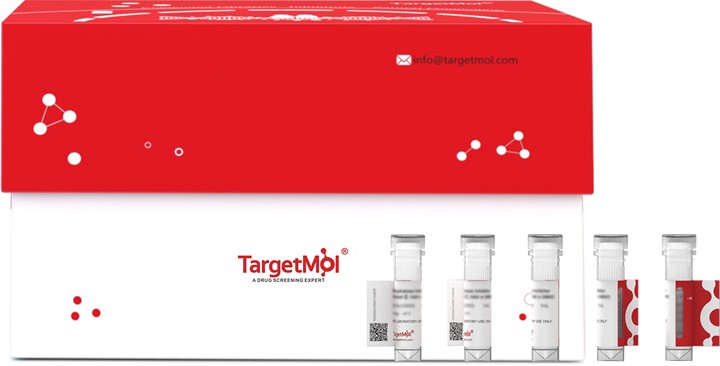 Your shopping cart is currently empty
Your shopping cart is currently empty
FKBP14 Protein, Human, Recombinant (His)
FKBP14 belongs to the FK506-binding protein family. It contains 2 EF-hand domains and one PPIase FKBP-type domain. FKBP14 can be detected in the lumen of the endoplasmic reticulum where it is thought to accelerate the folding of proteins during protein synthesis. Truncation of the amino-terminus of FKBP14 significantly decreases peptidyl prolyl cis-trans isomerase activity, therefore implicating that the PPIase FKBP-type domain must be located at the N-terminus. Defects in FKBP14 can cause Ehlers-Danlos syndrome with progressive kyphoscoliosis, myopathy, and hearing loss. A syndrome with features of Ehlers-Danlos syndrome types VIA and VIB on the one hand, and the collagen VI-related congenital myopathies Ullrich congenital muscular dystrophy and Bethlem myopathy on the other hand.

FKBP14 Protein, Human, Recombinant (His)
| Pack Size | Price | USA Warehouse | Global Warehouse | Quantity |
|---|---|---|---|---|
| 5 μg | $48 | 7-10 days | 7-10 days | |
| 10 μg | $76 | 7-10 days | 7-10 days | |
| 20 μg | $118 | 7-10 days | 7-10 days | |
| 50 μg | $237 | 7-10 days | 7-10 days | |
| 100 μg | $458 | 7-10 days | 7-10 days |
Product Information
| Biological Activity | Activity testing is in progress. It is theoretically active, but we cannot guarantee it. If you require protein activity, we recommend choosing the eukaryotic expression version first. |
| Description | FKBP14 belongs to the FK506-binding protein family. It contains 2 EF-hand domains and one PPIase FKBP-type domain. FKBP14 can be detected in the lumen of the endoplasmic reticulum where it is thought to accelerate the folding of proteins during protein synthesis. Truncation of the amino-terminus of FKBP14 significantly decreases peptidyl prolyl cis-trans isomerase activity, therefore implicating that the PPIase FKBP-type domain must be located at the N-terminus. Defects in FKBP14 can cause Ehlers-Danlos syndrome with progressive kyphoscoliosis, myopathy, and hearing loss. A syndrome with features of Ehlers-Danlos syndrome types VIA and VIB on the one hand, and the collagen VI-related congenital myopathies Ullrich congenital muscular dystrophy and Bethlem myopathy on the other hand. |
| Species | Human |
| Expression System | HEK293 Cells |
| Tag | C-His |
| Accession Number | Q9NWM8 |
| Synonyms | IPBP12,FKBP22,FK506 binding protein 14, 22 kDa,EDSKMH |
| Construction | A DNA sequence encoding the human FKBP14 (Q9NWM8) (Met1-Lys207) was expressed with a polyhistidine tag at the C-terminus. Predicted N terminal: Ala 20 |
| Protein Purity | > 95 % as determined by SDS-PAGE |
| Molecular Weight | 22.9 kDa (predicted); 25 and 27 kDa (reducing conditions) |
| Endotoxin | < 1.0 EU/μg of the protein as determined by the LAL method. |
| Formulation | Lyophilized from a solution filtered through a 0.22 μm filter, containing PBS, pH 7.4. Typically, a mixture containing 5% to 8% trehalose, mannitol, and 0.01% Tween 80 is incorporated as a protective agent before lyophilization. |
| Reconstitution | A Certificate of Analysis (CoA) containing reconstitution instructions is included with the products. Please refer to the CoA for detailed information. |
| Stability & Storage | It is recommended to store recombinant proteins at -20°C to -80°C for future use. Lyophilized powders can be stably stored for over 12 months, while liquid products can be stored for 6-12 months at -80°C. For reconstituted protein solutions, the solution can be stored at -20°C to -80°C for at least 3 months. Please avoid multiple freeze-thaw cycles and store products in aliquots. |
| Shipping | In general, Lyophilized powders are shipping with blue ice. |
| Research Background | FKBP14 belongs to the FK506-binding protein family. It contains 2 EF-hand domains and one PPIase FKBP-type domain. FKBP14 can be detected in the lumen of the endoplasmic reticulum where it is thought to accelerate the folding of proteins during protein synthesis. Truncation of the amino-terminus of FKBP14 significantly decreases peptidyl prolyl cis-trans isomerase activity, therefore implicating that the PPIase FKBP-type domain must be located at the N-terminus. Defects in FKBP14 can cause Ehlers-Danlos syndrome with progressive kyphoscoliosis, myopathy, and hearing loss. A syndrome with features of Ehlers-Danlos syndrome types VIA and VIB on the one hand, and the collagen VI-related congenital myopathies Ullrich congenital muscular dystrophy and Bethlem myopathy on the other hand. |
Dose Conversion
Calculator
Tech Support
| Size | Quantity | Unit Price | Amount | Operation |
|---|

Copyright © 2015-2025 TargetMol Chemicals Inc. All Rights Reserved.



